The National Bureau of Economic Research (NBER) recently declared that the latest recession officially ended in June 2009. With the onset being December 2007, the recession lasted 18 months, making it the longest recession since the end of World War II. The following table shows more recent recessions, including only those starting in the 1970s or later. The 1973-75 and 1981-82 recessions were only two months shorter than the most recent recession. So, in terms of severity, it is reasonable to compare the latest with these other two long downturns. Also, the prior most recent contraction was during 2001 — another interesting benchmark relative to today’s circumstances.
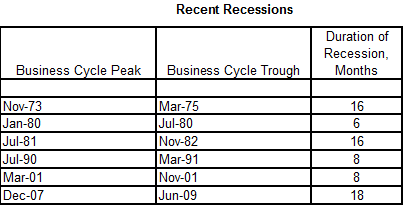
There is no shortage of sectors within the economy that can be compared. However, the more cyclical indicators are usually of more interest. These include employment, industrial production, housing starts, and motor vehicle sales. This article about cyclical comparisons focuses on these four cyclical indicators during the recessions of 1973-75, 1981-82, 2001, and 2007-09 and subsequent recoveries.
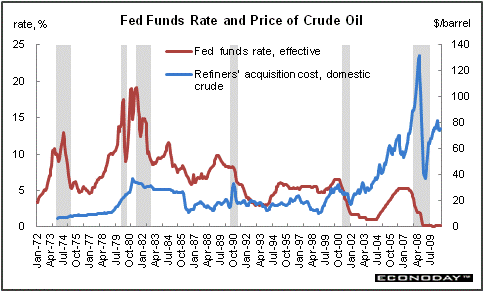
While recessions can be caused by a variety of factors, two have stood out over the last 40 years — monetary policy and spikes in the price of crude oil. Some recent recessions have been due to energy shocks — notably 1973-75, 1980, and 1981-82 with tight monetary policy also contributing to the latter two. Whether monetary policy (as indicated by the fed funds rate) is tight or loose has affected not just the depth of a recession but also how fast recovery took place.
The current recovery has been called a jobless recovery. But how does the latest recession and recovery compare to job decline and growth to prior business cycles' For all of these comparisons, data for each indicator (such as nonfarm payroll employment) are indexed to the peak of the prior cyclical expansion. The expansion peak is indexed to “1” so one can see by what percentage an indicator declines from the expansion peak to the bottom of the recession (trough). For example, the December 2007 expansion peak had employment at 137.951 million. All values for payroll employment for this recession are divided by that number so months before and after the peak are comparable. The charts show six months before the expansion peak and then another 32 months so the different cycles match the latest recession and recovery period through August 2010.
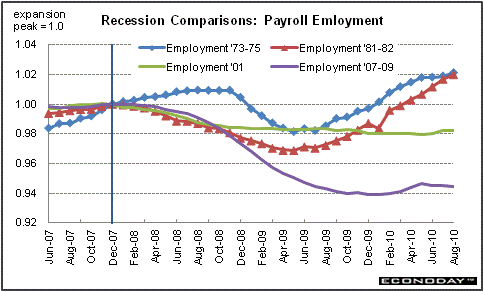
Indeed, the latest recession and beginnings of recovery had the worst outcome for employment. Although the 1981-82 and the 2001 recessions initially showed a faster drop in payroll employment, the 2007-09 contraction sank longer and sharper. The latest recession had a drop in employment of 6.1 percent from December 2007 to the employment trough in December 2009. The second closest recession in terms of percentage loss was the 1981-82 recession, down 3.1 percent. Employment patterns have varied significantly. For 1973-75, job growth actually continued for eight months into the overall recession as it took employers a while to realize that demand was on true downtrend. Job losses in the 2001 recession were modest — down only 2.0 percent from expansion peak to employment low. It now has been 38 months from the latest expansion peak of December 2007 to August 2010 — the latest month available for employment. This recovery has employment still down 5.5 percent from the expansion peak. This compares to 1973-75, up 2.1 percent; 1981-82, up 2.0 percent; and 2001, down 1.8 percent.
Employment is not the only sector that was hard hit in the latest recession. Manufacturing is very cyclical — especially for durables. For the latest recession, industrial production plunged 14.9 percent before rebounding in mid-2009. The 1973-75 recession was almost as severe with output down 13.0 percent at the minimum for industrial production. Other downturns were not as dramatic.
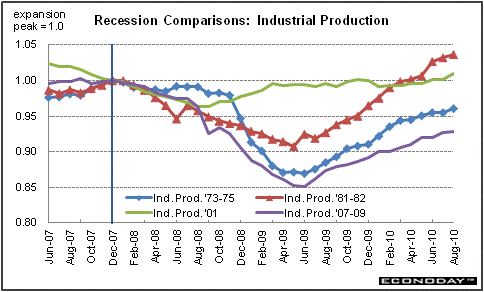
Even though growth in manufacturing has been a key factor in the current recovery, the magnitude of the rebound in industrial production has been lackluster compared to earlier recoveries. At 38 months past the prior expansion peak, industrial production in August 2010 was still 7.2 percent below the December 2007 level — meaning it was far from full recovery. In contrast, the rebounds in production after the troughs in 1981-82 and in 2001 had surpassed the prior peak at this point. However, industrial output had started to decline well ahead of the overall economy in 2001.
One reason that industrial production may be relatively weak currently is the sluggishness of motor vehicle sales. Auto sales are sensitive to both interest rate levels and employment changes. The chart below shows the Bureau of Economic Analysis’ series for unit new motor vehicle purchases for the four recession periods. Despite some volatility in monthly numbers, all four recessions initially showed moderate reductions in the sales pace early in downturn.

However, the latest contraction turned much uglier for auto sales within a year of the prior peak. This was due in part to notably worse employment losses. This cycle, however, had the added downward pressure on sales from rising expectations that some U.S. automakers would be and eventually did file bankruptcy (as was the case for GM and Chrysler). In contrast, sales in earlier recoveries were benefitting from Fed rate cuts but were not suffering from consumer fears over manufacturer bankruptcies. Also, credit standards had not tightened during recovery. For the latest recession, unit new motor vehicle sales were down a whopping 40.7 percent at sales bottom compared to December 2007. As of August, motor vehicle purchases were still down 27.3 percent from the end of prior expansion.
Not surprisingly, the sector hardest hit this recession and the following recovery — relative to other business cycles — is housing. As is common for leading indicators, housing starts headed down well before overall recession. But from December 2007 to this indicator’s low, starts plunged 54.0 percent for the latest recession. The next worst recession for housing starts was during 1973-75 when starts sank 47.5 percent.
Typically, cuts in interest rates and homebuilder expectations for a boost in home sales lead to gains in housing starts early in recovery. That did not happen with the current recovery as starts only got a mild lift from special tax incentives for homebuyers in late 2009 and early 2010. As of August 2010, starts were still 42.3 percent below the pace seen December 2007. The next worst recovery was for 1973-75 and for the comparable period, starts were down 18.7 percent.
What are the big differences this recovery' As already noted, employment remains depressed, resulting in low job mobility and lower turnover rates for homes on the market. Additionally, starts have been kept down by the decline in home prices, tighter mortgage standards and bloated inventories.
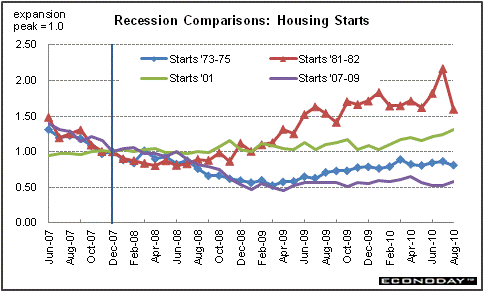
Data for key indicators clearly confirm that the past recession has been the worst since the 1940s with weakness spread across a variety of sectors. In general, cyclically sensitive sectors likely will show only modest improvement until employment strengthens. The sector that likely will continue outperform others is manufacturing as it gets a boost from export demand and is not quite as dependent on domestic job gains.
|

